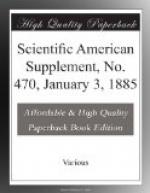About ten minutes from the commencement of artificial respiration we noticed a single weak spasmodic contraction of the diaphragm, the feeblest possible effort at natural respiration. Simultaneously, very distant weak reduplicated cardiac pulsations, numbering about 150 to the minute, became evident to the stethoscope. The reduplication implied that the two sides of the heart were not acting synchronously, owing to obstruction to the pulmonary circulation induced by the asphyxiated state. Artificial respiration was steadily maintained, and during the next half hour spasmodic contractions of the diaphragm occurred at gradually diminishing intervals, from once in three minutes to three or four times a minute.
These natural efforts were artificially aided as far as possible. At 5:45 P.M. natural respiration was fairly though insufficiently established, the skin began to lose its deadly hue, and titillation of the fauces caused weak reflex contractions. Flagellation with wet towels was now freely resorted to, and immediately the natural efforts at respiration were increased to twice their previous number. The administration of a little brandy and water by the mouth failed, as the liquid entered the larynx. Ammonia was applied to the nostrils, and the surface temperature was increased by warm applications and clothing. At 6 P.M. artificial respiration was no longer necessary. The heart sounds then numbered 140 to the minute, the right and left heart still acting separately. A very small radial pulse could also be felt. At 6:45 P.M. the woman was put to bed, warmth of surface maintained, and hot coffee and beef-tea given in small quantities.
Great restlessness and jactitation set in with the renewal of the circulation in the extremities. An enema of two ounces of strong beef-tea was administered at 10 P.M. The amount of organic effluvium thrown off by the lungs on the re-establishment of respiration was very great and tainted the atmosphere of the room and adjoining ward. The pupils, previously widely dilated, began to contract to light at 11 P.M. Imperfect consciousness returned at 5 P.M. the following day (Dec. 1), and about an hour later she vomited the contents of the stomach (bread, etc., taken on Nov. 30). Small quantities of beef-tea were given by the mouth during the night. At 9 A.M. air entered the lungs freely, and there were no symptoms of pulmonary engorgement beyond slight basic hypostasis; the pulse remained at 140, and the heart sounds reduplicated; she was semiconscious, very drowsy, in a state of mental torpor, with confused ideas when roused, and she complained of rheumatic-like pains all over her.




